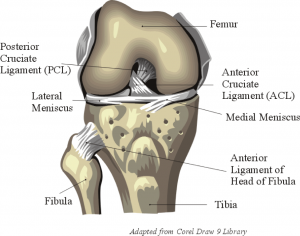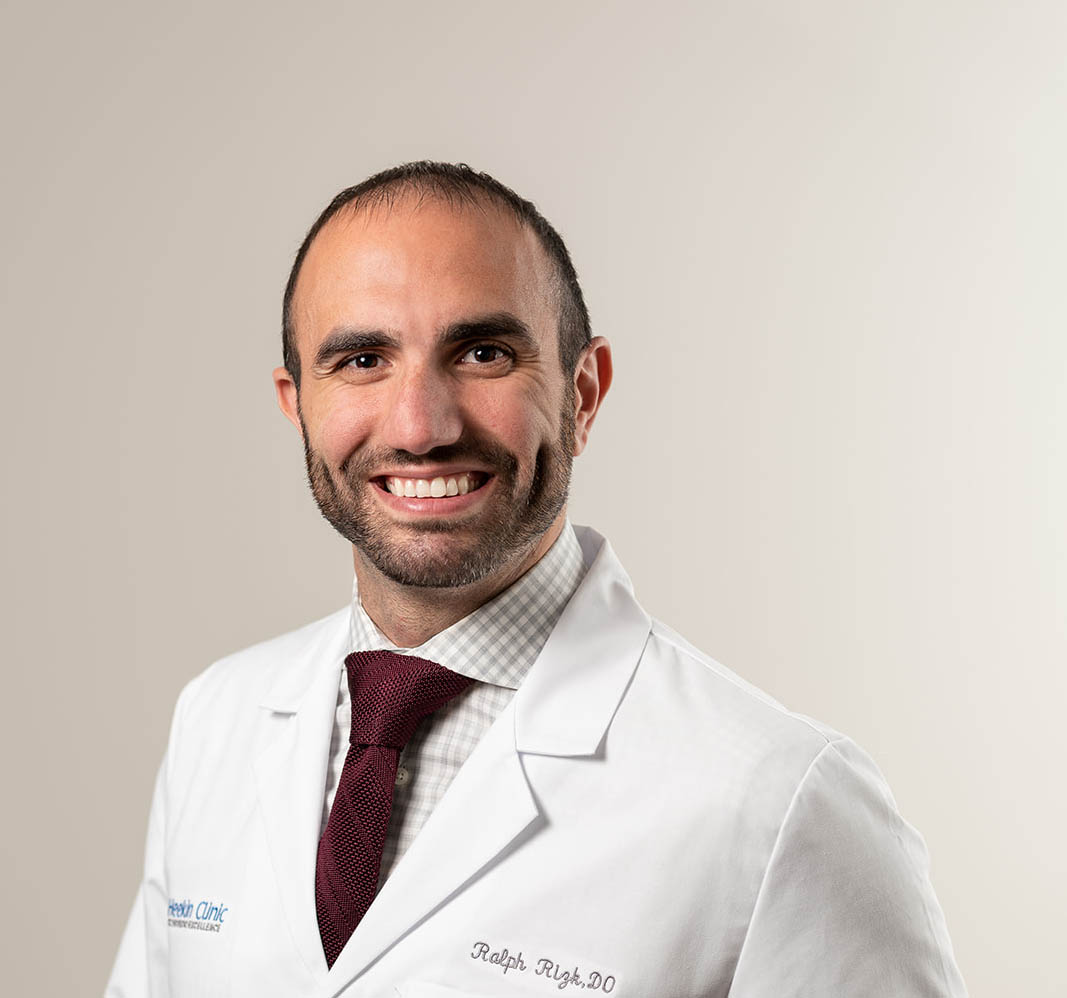Knee
Knee Care That Gets You Moving
Knee pain impacts your ability to move comfortably throughout your day and life. Dr. Rizk is an expert in treating knee and lower extremity conditions using the most advanced techniques, giving you back the range of motion you need to continue on your day-to-day without pain. You can be confident that you’ll receive the very best knee care that will get you on the move again. For knee replacement, click here.
Orthopaedic Knee Information
The most common types of arthritis are osteoarthritis and rheumatoid arthritis, but there are actually more than 100 different types of inflammatory arthritis. According to the NIH, in 2012, more than 51 million people suffered from some form of arthritis. According to the Arthritis Foundation, nearly two-thirds of sufferers are under the age of 65. Juvenile arthritis refers to the many degenerative arthritic conditions that affect children.
Knee Pain Causes & Treatment Options Explained by Dr. Rizk
Normal Anatomy of the Knee
The knee is the largest and strongest joint in your body. It is made up of the lower end of the femur (thighbone), the upper end of the tibia (shinbone), and the patella (kneecap). The ends of the three bones, where they touch, are covered with articular cartilage, a smooth, slippery substance that protects and cushions the bones as you bend and straighten your knee.
Two wedge-shaped pieces of cartilage, called a meniscus, act as “shock absorbers” between your thighbone and shinbone. They are tough and rubbery to help cushion the joint and keep it stable.
The knee joint is surrounded by a thin lining called the synovial membrane. This membrane releases a fluid that lubricates the cartilage and reduces friction.

Types of Arthritis
The major types of arthritis that affect the knee are osteoarthritis, rheumatoid arthritis, and post-traumatic arthritis.
The most common type of arthritis is osteoarthritis, a progressive disease that slowly wears away joint cartilage. This type of arthritis is often seen after middle age and is referred to as “wear and tear” arthritis. As the protective cartilage is worn away, bone is exposed, the knee becomes swollen and painful, and activities become increasingly painful. This type of arthritis may also have a genetic component as it seems to run in families.
Rheumatoid Arthritis
Rheumatoid arthritis is an inflammatory disease that can strike at any age. It is often managed conservatively by a rheumatologist, who specializes in the disease.
When arthritis develops following an injury to the knee, shoulder, ankle or hip, it is called post-traumatic arthritis. It can occur years after a torn meniscus, injury to a ligament, or fracture of the knee or other joint.
Symptoms of Rheumatoid Arthritis
A knee joint affected by arthritis is often painful and inflamed. Generally, the pain develops gradually over time, although sudden, onset pain is also possible. Other symptoms include:
- A stiff and swollen knee that is difficult to bend and/or straighten.
- Pain and swelling that is worse in the morning or after periods of sitting or resting.
- Vigorous activity or long periods of walking may cause pain to flare up.
- The knee may exhibit “locking” or “sticking” during motion. This is caused by loose bodies that may exist in the knee. The knee may creak, click, snap or make a grinding noise (crepitus).
- Pain may cause a feeling of weakness or buckling in the knee.
- Many people with arthritis note increased joint pain during rainy weather.
Arthritis Diagnosis
During your appointment, your doctor will talk with you about your symptoms and medical history, conduct a physical examination, and order imaging such as x-rays.
Dr. Rizk will look for:
- Joint swelling, warmth or redness
- Tenderness about the knee
- Range of passive (assisted) and active (self-directed) motion
- Instability of the joint
- Crepitus (a grating sensation inside the joint) with movement
- Pain when weight is placed on the knee
- Problems with your gait (the way you walk)
- Any signs of injury to the muscles, tendons and ligaments surrounding the knee
- Involvement of other joints (an indication of rheumatoid arthritis)
Imaging Tests
X-rays: These imaging tests create detailed pictures of dense structures, such as bone. They can help distinguish between various forms of arthritis. X-rays of an arthritic knee may show a narrowing of the joint space, changes in the bone, and the formation of bone spurs (osteophytes).
Other tests: Occasionally, a magnetic resonance imaging (MRI) scan, a computed tomography (CT) scan, or a bone scan may be needed to determine the condition of the bone and soft tissues of your knee.
Arthritis Treatment
There is no cure for arthritis, but there are a number of treatments, both surgical and non-surgical, that are effective at relieving the pain and disability it can cause.
Nonsurgical Treatment
As is common with any arthritic condition, the initial treatment for arthritis of the knee is typically conservative. These conservative treatment options can include:
Lifestyle Modifications
- Some changes in your daily life can protect your knee joint and slow the progress of arthritis.
- Minimize activities that aggravate the condition such as climbing stairs.
- Switching from high impact activities (such as jogging or tennis) to lower impact activities (such as swimming or cycling) will put less stress on your knee.
- Losing weight can reduce stress on the knee-joint resulting in less pain and increased function.
Physical Therapy
Physical therapists can identify exercises that help increase range of motion and flexibility, as well as help strengthen the muscles in your leg. Your therapist can define an individualized exercise program that meets your needs and lifestyle.
Assistive Devices
Using devices such as a cane, wearing shock-absorbing shoes or inserts, or wearing a brace or knee sleeve, can be helpful. A brace assists with stability and function and may be especially helpful if the arthritis is centered on one side of the knee. There are two types of braces that are often used for knee arthritis. An “unloader” brace shifts weight away from the affected portion of the knee, while a “support” brace helps support the entire knee load.
Other Treatments
Applying heat or ice, using pain-relieving ointments or creams, or wearing elastic bandages to provide support to the knee may provide some relief from pain. Glucosamine and chondroitin sulfate, substances found naturally in joint cartilage, can be taken as dietary supplements. Although patient reports indicate that these supplements may relieve pain, there is no evidence to support the use of glucosamine and chondroitin sulfate to decrease or reverse the progression of arthritis.
Arthritis Medications & Injections
Surgical Treatment for Arthritis
Dr. Rizk will recommend surgery if your pain from arthritis causes disability and is not relieved with nonsurgical treatment. As with all surgeries, there are some risks and possible complications with various knee procedures. Your doctor will discuss the possible complications with you before your operation.
Arthoscopy
During arthroscopy, doctors use small incisions and thin instruments to diagnose and treat joint problems.
Arthroscopic Surgery: This type of surgery is not often used to treat arthritis of the knee. In cases where mild osteoarthritis is accompanied by a degenerative meniscal tear or made worse by loose bodies or bone spurs, arthroscopic surgery may be recommended to treat the other issues.
Total Knee Replacement (Arthoplasty)
Dr. Rizk will remove the damaged cartilage and bone and then position new metal or plastic joint surfaces to restore function and renew stability and movement.
Overall, there are two primary benefits from knee replacement surgery:
1) Elimination of pain
(2) Improved range of motion
Of all possible surgical interventions, total knee replacement offers the greatest quality of life improvement. The procedure has a high rate of success.
Arthritic Knee Surgery Recovery
After any type of surgery for arthritis of the knee, there is a period of recovery. Recovery time and rehabilitation depend on the type of surgery performed.
Dr. Rizk will prescribe physical therapy to help you regain strength in your knee and to restore range of motion. Depending upon your procedure, you may need to wear a knee brace or use crutches or a cane for a period of time.
In most cases, surgery relieves pain and makes it possible to perform daily activities more easily.
Meet Our Doctor

RALPH RIZK, DO
Orthopaedic Surgeon
Dr. Ralph Rizk is an Orthopaedic Surgeon who treats both adults and adolescent patients. He practices surgical Orthopaedics, specializing in Adult Hip and Knee Reconstruction Surgery […]
Wanda H.
PATIENT OF DR. RALPH RIZK
Better Health Care is Our Mission
Flexible scheduling and same-day appointments available!
